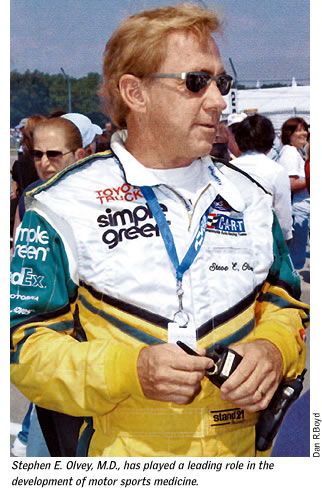|
 One hundred percent fatal. That’s how trauma physicians
describe a bilateral above the knee traumatic amputation.
No one can survive the profuse bleeding unless competent
help arrives immediately. One hundred percent fatal. That’s how trauma physicians
describe a bilateral above the knee traumatic amputation.
No one can survive the profuse bleeding unless competent
help arrives immediately.
Without a miracle, race car driver Alex
Zanardi would be dead in four minutes. Help arrived in
just 19 seconds.
“The Zanardi crash was a situation where an individual sustained
an injury that was considered universally fatal,” says
Stephen E. Olvey, M.D., associate professor of neurological
surgery and one of the physicians who treated Zanardi
that day.
Zanardi was saved, not only by the physicians
who treated him at a German race course in September
2001, but
by a long investment in safety.
Olvey has now written a book about his
40 years of providing emergency medicine to injured race
car drivers. Rapid
Response: My inside story as a motor racing life-saver tells
the story of the evolution of motor sports medicine,
an
effort led by Olvey and a handful of other physicians.
Olvey first worked as a track physician
in Indianapolis in 1966, when a hearse served as an ambulance
and intensive-care
specialists were nowhere to be found. “In Milwaukee
the medical director was an Ob/Gyn,” he recalls.
And in the 1960s, one out of seven drivers
involved in a crash was killed.
“I started the first program where the same physicians went
around to the races,” says Olvey, who is also
director of the Neurosurgical Intensive Care Unit at
Jackson Memorial
Hospital, but who grew up in Indianapolis. “We
standardized things.”
Olvey recounts the inadequacy of motor
sports medicine through the 1950s and ’60s, when
deaths from fire and head injury permeated the sport.
Swede Savage crashed
in an inferno in 1973 and died a month later from complications
related to contaminated plasma. Gordon Johncock suffered
a badly broken leg racing in Milwaukee—then was
accidentally dumped from the back of the ambulance.
In 1975, as the new assistant medical
director at the Indianapolis Motor Speedway, Olvey was
put in charge
of organizing more
consistent and better medical care at the various Indy
car tracks. By the early 1980s, a trained physician—often
Olvey—would usually be on the scene within 30
seconds after a crash. Tracks offered medical facilities
equipped
like trauma hospitals and required medical helicopters.
In 1996 driver Emerson Fittipaldi, who
lives part time in Miami, crashed at Michigan International
Speedway,
severely fracturing his cervical spine. Not agreeing
with the care
offered in Michigan, Olvey flew Fittipaldi to UM/Jackson,
where he had successful surgery led by Barth A. Green,
M.D., F.A.C.S., professor and chairman of the Department
of Neurological Surgery, and Frank J. Eismont, M.D.,
professor and chairman of the Department of Orthopaedics.
Olvey says many physicians were focused
on saving an injured driver’s life but not thinking about getting them
back into a race car. Instead, he and his colleagues worked
on restoring drivers’ ability to compete.
Zanardi, the driver who lost his legs,
returned to the German track where he was injured two
years later
to
drive his last 13 laps with prosthetic legs.
At full speed. |